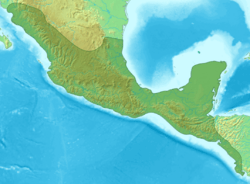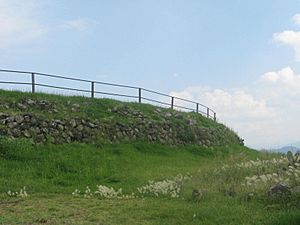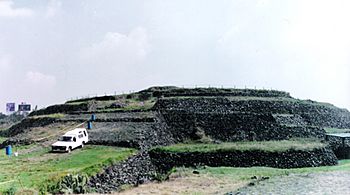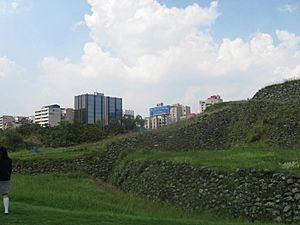Cuicuilco facts for kids
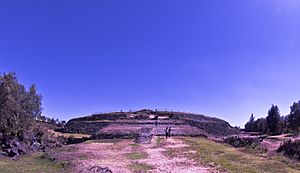
Western side of the circular pyramid at Cuicuilco.
|
|
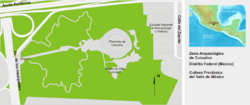 |
|
| Location | Valley of Mexico, Mexico |
|---|---|
| Region | Valley of Mexico |
| Coordinates | 19°18′06″N 99°10′54″W / 19.30167°N 99.18167°W |
| History | |
| Founded | Around 1000 BCE |
| Abandoned | 2nd–3rd century CE |
| Periods | Preclassic to Early Classic |
Cuicuilco was an important ancient city located in the southern part of the Valley of Mexico. Today, its ruins are found in Mexico City, specifically in the Tlalpan area.
This city started to be built many centuries ago, around 1000 BCE. It was an active place until a volcano called Xitle erupted, destroying it sometime between 245 and 315 CE.
Cuicuilco might be the oldest city in the Valley of Mexico. It existed at the same time as the Olmecs, another famous ancient culture in Mexico.
Contents
Why Was Cuicuilco Important?
Cuicuilco was the first major religious and community center in the Mexican Plateau. It had different kinds of people and cultural traditions that would later be seen in other big Mesoamerican cities.
It was also one of the first places in Mesoamerica to form a state, meaning it had an organized government and society. The city invested a lot in building projects, like its famous pyramid.
Cuicuilco even became a rival to Teotihuacan, another powerful city about 60 kilometers away. They often had conflicts, building defenses against each other.
The eruption of the Xitle volcano destroyed Cuicuilco. This event caused many people to move and led to Teotihuacan becoming the most powerful city in the Central Highlands.
Today, you can still see eight of the many buildings that once stood there. There are also remains of a system that brought water to the city. One of the pyramids was built in a special spot, showing how ancient people connected their religious beliefs with the sky and stars.
What Does "Cuicuilco" Mean?
The exact meaning of the name "Cuicuilco" is not fully known.
However, an archaeologist named Zelia Nuttall believed it meant "Place where songs and dances are made." This sounds like a fun and lively place!
The Story of Cuicuilco
Cuicuilco began as a small farming village. But even early on, people practiced religious rituals, leaving stone offerings and using ceramic items in burials.
The village grew into a large city with a main ceremonial center. This center included pyramids, plazas, and roads. There were also small, shallow pools fed by water from nearby hills. At its peak, about 20,000 people lived in Cuicuilco.
The city had terraces, various buildings, and systems for irrigation (watering crops). The most famous structure is a large pyramid base, built around 800–600 BCE.
Archaeological findings, like pottery and buildings, show that Cuicuilco grew steadily during the Preclassic period. Its people traded and interacted with other sites, both nearby and far away.
The earliest signs of people living here date back to 1200 BCE. Around 1000–800 BCE, they started building unique cone-shaped structures with oval bases. These sites were like early regional capitals, bringing together smaller communities.
The great pyramid of Cuicuilco was likely built between 800 and 600 BCE, showing how much the city had developed. Cuicuilco started to decline between 100 BCE and 1 CE, just as Teotihuacan began to grow into a major urban center.
How the Culture Grew
Around 800 BCE, small settlements in the area started to grow. By 100 CE, they had become major cities with complex rituals and social classes, similar to Teotihuacan.
Some experts think Cuicuilco grew because of its good location. It was near a mountain pass and close to the shores of Lake Texcoco.
By 150 BCE, Cuicuilco was a big regional center with about 20,000 people. However, its growth was stopped by the eruption of the Xitle volcano. The lava covered much of the city, which was thought to be about 400 hectares (about 1,000 acres) in size.
What We Know About the People of Cuicuilco
The people of Cuicuilco sometimes shaped their heads, making them round or elongated. They also practiced dental modification. On average, they lived to about 51 years old.
Farming and Food in Ancient Cuicuilco
The people of Cuicuilco had access to many natural resources. They lived about 4 kilometers from Lake Xochimilco and near the Sierra de las Cruces and Ajusco mountains. There were also springs and streams nearby.
Their main way of getting food was through farming. They likely also hunted, fished, and gathered food from the forests. They had easy access to wood and farmland, though much of it is now buried under lava and modern buildings.
The End of Cuicuilco's Culture
Cuicuilco began to decline in the early 1st century BCE, as Teotihuacan became more powerful. Around 400 CE, the Xitle volcano, located near Ajusco, erupted. This eruption buried and destroyed what was left of Cuicuilco and another important center called Copilco.
This disaster caused many Cuicuilco people to move to other areas, including Teotihuacan. Teotihuacan then adopted many features of their culture.
Even after the volcano covered Cuicuilco in lava, people continued to leave offerings at the site. The lava flows are still visible today, showing how much of the city was destroyed. This series of eruptions helped Teotihuacan become the main power in the Valley of Mexico.
Archaeologists believe Cuicuilco was a very important community before Teotihuacan became a big city. While Cuicuilco was building pyramids, Teotihuacan was just starting to grow. The city was abandoned around 150 to 200 CE after the Xitle eruption. Pottery found suggests that people who escaped the volcano moved north and joined the population of Teotihuacan.
Exploring the Ancient Site
The Cuicuilco site is covered by a thick layer of volcanic lava, known as the Pedregal de San Ángel. This lava field covers about 80 square kilometers. A study in 1956 found that these uneven lava deposits, sometimes over 10 meters deep, helped preserve Cuicuilco.
The site is now part of a modern city and is partly covered by buildings from the National University of Mexico. Because of this, only some archaeological investigations have been possible. Modern construction has unfortunately damaged parts of the ancient city. For example, in the 1990s, some circular pyramids and other structures were destroyed to build an office complex. This makes it hard to know the true size and complexity of Cuicuilco.
More Discoveries at Cuicuilco
The lava flow from the volcano sealed and preserved the ancient settlement and its surroundings. This means archaeologists can study materials from before the eruption.
The lava also created a marshy area on the eastern side of a nearby lake. Layers of volcanic ash from Xitle and possibly Popocatepetl have been found in this marsh.
Some experts also think other volcanoes in the area, like Chichinautzin and Yololica, might have erupted around the same time as Xitle, causing similar changes to the environment.
During explorations in the 1920s, archaeologists found pottery from before the eruption. In 1939, burials were excavated near the main pyramid, called Cuicuilco A. Later studies in 1957 helped create a timeline for the main pyramid.
Between 1966 and 1968, more buildings and cone-shaped structures were found in an area called Cuicuilco B. Over 300,000 ceramic pots were discovered there! Based on these pots, archaeologists believe people continued to live in Cuicuilco even after the Xitle eruption, though the city's importance and population greatly decreased.
In 1990, in an area called Cuicuilco C, archaeologists found mostly pottery from the Preclassic period, but also some from later times, including colonial and modern periods.
Studies of the soil layers show that after the Xitle eruption, materials were deposited on top of lava that had cooled in water. This suggests that small settlements existed from about 200 to 950 CE.
Archaeological finds tell us about the daily lives and beliefs of the people. They threw broken pots into the water, especially everyday items like pans and pitchers. But they also threw special items like small braziers and Tlaloc vases (for the rain god) into the water as offerings, similar to rituals recorded by Spanish historians in other ancient Mexican cities.
Many ceramic items found date to the peak of Teotihuacan's power (200 to 650 CE). Other items are from later periods (650-950 CE), showing connections with other important sites like Cerro de la Estrella and Azcapotzalco (altepetl). There are also some items linked to the Toltec State, which existed between 950 and 1150 CE.
These findings show strong connections between the Valley of Mexico and other regions. They also reveal how new societies formed after the decline of the Teotihuacan Empire and how the Toltec State emerged.
In some areas, archaeologists found Aztec ceramics from before the Spanish arrived, as well as items from the colonial period and even 19th-century European pottery. This shows that people continued to live in Cuicuilco for a very long time, even after it was buried by lava.
Cuicuilco Today
Cuicuilco faces challenges because of its location in a modern city. There are conflicts between urban development and the need to protect this important archaeological site.
The known site of Cuicuilco is divided into two main areas. Cuicuilco A is where the main ceremonial center is located. Cuicuilco B is to the west, near the Olympic Village Sports Centre.
Historians and archaeologists all agree on Cuicuilco's importance. However, it hasn't been studied as much as other sites like Teotihuacan. The biggest challenge is that most of the area is covered by a lava layer about 9 to 10 meters thick. On top of that, modern buildings, like the Telmex building and the Cuicuilco commercial plaza, have been built directly over parts of the ancient city.
The Cuicuilco Site Museum was designed by a famous Mexican architect.
Images for kids
-
This "kiva" was discovered and named by archeologist Byron Cummings, who likened it to semi-buried round chambers found in the SW U.S. Its ritual purpose is unknown.
-
Looking southwest from the top of the pyramid with the Villa Olimpica (now housing) built for the 1968 Summer Olympics
See also
 In Spanish: Cuicuilco para niños
In Spanish: Cuicuilco para niños


